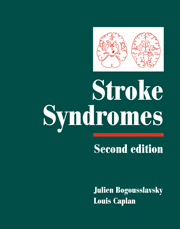Book contents
- Frontmatter
- Contents
- List of contributors
- Preface
- PART I CLINICAL MANIFESTATIONS
- PART II VASCULAR TOPOGRAPHIC SYNDROMES
- 29 Arterial territories of human brain
- 30 Superficial middle cerebral artery syndromes
- 31 Lenticulostriate arteries
- 32 Anterior cerebral artery
- 33 Anterior choroidal artery territory infarcts
- 34 Thalamic infarcts and hemorrhages
- 35 Caudate infarcts and hemorrhages
- 36 Posterior cerebral artery
- 37 Large and panhemispheric infarcts
- 38 Multiple, multilevel and bihemispheric infarcts
- 39 Midbrain infarcts
- 40 Pontine infarcts and hemorrhages
- 41 Medullary infarcts and hemorrhages
- 42 Cerebellar stroke syndromes
- 43 Extended infarcts in the posterior circulation (brainstem/cerebellum)
- 44 Border zone infarcts
- 45 Classical lacunar syndromes
- 46 Putaminal hemorrhages
- 47 Lobar hemorrhages
- 48 Intraventricular hemorrhages
- 49 Subarachnoid hemorrhage syndromes
- 50 Brain venous thrombosis syndromes
- 51 Carotid occlusion syndromes
- 52 Cervical artery dissection syndromes
- 53 Syndromes related to large artery thromboembolism within the vertebrobasilar system
- 54 Spinal stroke syndromes
- Index
- Plate section
29 - Arterial territories of human brain
from PART II - VASCULAR TOPOGRAPHIC SYNDROMES
Published online by Cambridge University Press: 17 May 2010
- Frontmatter
- Contents
- List of contributors
- Preface
- PART I CLINICAL MANIFESTATIONS
- PART II VASCULAR TOPOGRAPHIC SYNDROMES
- 29 Arterial territories of human brain
- 30 Superficial middle cerebral artery syndromes
- 31 Lenticulostriate arteries
- 32 Anterior cerebral artery
- 33 Anterior choroidal artery territory infarcts
- 34 Thalamic infarcts and hemorrhages
- 35 Caudate infarcts and hemorrhages
- 36 Posterior cerebral artery
- 37 Large and panhemispheric infarcts
- 38 Multiple, multilevel and bihemispheric infarcts
- 39 Midbrain infarcts
- 40 Pontine infarcts and hemorrhages
- 41 Medullary infarcts and hemorrhages
- 42 Cerebellar stroke syndromes
- 43 Extended infarcts in the posterior circulation (brainstem/cerebellum)
- 44 Border zone infarcts
- 45 Classical lacunar syndromes
- 46 Putaminal hemorrhages
- 47 Lobar hemorrhages
- 48 Intraventricular hemorrhages
- 49 Subarachnoid hemorrhage syndromes
- 50 Brain venous thrombosis syndromes
- 51 Carotid occlusion syndromes
- 52 Cervical artery dissection syndromes
- 53 Syndromes related to large artery thromboembolism within the vertebrobasilar system
- 54 Spinal stroke syndromes
- Index
- Plate section
Summary
Introduction
The advent of neuroimaging has allowed clinicians to improve clinico-anatomic correlations in patients with strokes. Anatomic structures are now well delineated on magnetic resonance imaging, and a knowledge of arterial territories is needed to achieve accurate localization of ischemic lesions.
MRI studies have re-evaluated the clinical spectrum of both anterior and posterior circulation strokes. Because the topographic, etiologic, and clinical spectra vary, large prospective studies including well-documented patients are of upmost importance. Classical syndromes have been revisited and new clinical patterns highlighted. However, most of the recent studies are based on various anatomic support and sometimes even lack anatomic reference. In this latter case, MRI is sometimes even considered to be an effective means of identifying etiologies according to the location of the infarction. On the other hand, only scarce reports exist in which the arterial vascular territories are well identified by anatomic studies. This lack of standardization in both arterial territory localization and the planes used to identify them, mar totally the accuracy of such reports. This recent neuroimaging development necessitates a precise and standardized tool for anatomo-radioclinical correlations.
However, a perfect knowledge in the general organization of brain arterial circulation is the first step needed for a good understanding in some particularities of brain arterial territories. The present chapter is designed to show precise brain arterial circulation organization and to depict brain arterial territories in a form directly applicable to neuroimaging slices in clinical practice.
General organization of brain arterial circulation
Brainstem
Arterial trunks supplying the brainstem include: vertebral artery, basilar artery, anterior and posterior spinal arteries, posterior inferior cerebellar artery, anterior inferior cerebellar artery, superior cerebellar artery, posterior cerebral artery, and anterior choroidal artery (Fig. 29.1).
- Type
- Chapter
- Information
- Stroke Syndromes , pp. 375 - 404Publisher: Cambridge University PressPrint publication year: 2001
- 23
- Cited by

